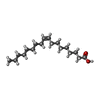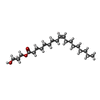[English] 日本語
 Yorodumi
Yorodumi- PDB-7zly: Crystal structure of human GPCR Niacin receptor (HCA2) expressed ... -
+ Open data
Open data
- Basic information
Basic information
| Entry | Database: PDB / ID: 7zly | ||||||||||||||||||
|---|---|---|---|---|---|---|---|---|---|---|---|---|---|---|---|---|---|---|---|
| Title | Crystal structure of human GPCR Niacin receptor (HCA2) expressed from Spodoptera frugiperda | ||||||||||||||||||
 Components Components | Hydroxycarboxylic acid receptor 2,Soluble cytochrome b562 | ||||||||||||||||||
 Keywords Keywords |  MEMBRANE PROTEIN / MEMBRANE PROTEIN /  Niacin receptor / hydroxycarboxylic acid receptor 2 / HCA2 / Niacin receptor / hydroxycarboxylic acid receptor 2 / HCA2 /  GPCR / GPCR /  membrane protein structure membrane protein structure | ||||||||||||||||||
| Function / homology |  Function and homology information Function and homology information nicotinic acid receptor activity / Hydroxycarboxylic acid-binding receptors / neutrophil apoptotic process / Class A/1 (Rhodopsin-like receptors) / positive regulation of neutrophil apoptotic process / positive regulation of adiponectin secretion / negative regulation of lipid catabolic process / nicotinic acid receptor activity / Hydroxycarboxylic acid-binding receptors / neutrophil apoptotic process / Class A/1 (Rhodopsin-like receptors) / positive regulation of neutrophil apoptotic process / positive regulation of adiponectin secretion / negative regulation of lipid catabolic process /  cell junction / G alpha (i) signalling events / cell junction / G alpha (i) signalling events /  electron transfer activity ... electron transfer activity ... nicotinic acid receptor activity / Hydroxycarboxylic acid-binding receptors / neutrophil apoptotic process / Class A/1 (Rhodopsin-like receptors) / positive regulation of neutrophil apoptotic process / positive regulation of adiponectin secretion / negative regulation of lipid catabolic process / nicotinic acid receptor activity / Hydroxycarboxylic acid-binding receptors / neutrophil apoptotic process / Class A/1 (Rhodopsin-like receptors) / positive regulation of neutrophil apoptotic process / positive regulation of adiponectin secretion / negative regulation of lipid catabolic process /  cell junction / G alpha (i) signalling events / cell junction / G alpha (i) signalling events /  electron transfer activity / electron transfer activity /  periplasmic space / iron ion binding / G protein-coupled receptor signaling pathway / periplasmic space / iron ion binding / G protein-coupled receptor signaling pathway /  heme binding / heme binding /  plasma membrane plasma membraneSimilarity search - Function | ||||||||||||||||||
| Biological species |   Homo sapiens (human) Homo sapiens (human)  Escherichia coli (E. coli) Escherichia coli (E. coli) | ||||||||||||||||||
| Method |  X-RAY DIFFRACTION / X-RAY DIFFRACTION /  SYNCHROTRON / SYNCHROTRON /  MOLECULAR REPLACEMENT / Resolution: 2.7 Å MOLECULAR REPLACEMENT / Resolution: 2.7 Å | ||||||||||||||||||
 Authors Authors | Yang, Y. / Kang, H.J. / Gao, R.G. / Wang, J.J. / FiBerto, J.F. / Wu, L.J. / Tong, J.H. / Han, G.W. / Qu, L. / Wu, Y.R. ...Yang, Y. / Kang, H.J. / Gao, R.G. / Wang, J.J. / FiBerto, J.F. / Wu, L.J. / Tong, J.H. / Han, G.W. / Qu, L. / Wu, Y.R. / Pileski, R. / Li, X.M. / Zhang, X.C. / Zhao, S.W. / Kenakin, T. / Wang, Q. / Stevens, R.C. / Peng, W. / Roth, B.L. / Rao, Z.H. / Liu, Z.J. | ||||||||||||||||||
| Funding support |  China, 5items China, 5items
| ||||||||||||||||||
 Citation Citation |  Journal: Nat Commun / Year: 2023 Journal: Nat Commun / Year: 2023Title: Structural insights into the human niacin receptor HCA2-G signalling complex. Authors: Yang Yang / Hye Jin Kang / Ruogu Gao / Jingjing Wang / Gye Won Han / Jeffrey F DiBerto / Lijie Wu / Jiahui Tong / Lu Qu / Yiran Wu / Ryan Pileski / Xuemei Li / Xuejun Cai Zhang / Suwen Zhao ...Authors: Yang Yang / Hye Jin Kang / Ruogu Gao / Jingjing Wang / Gye Won Han / Jeffrey F DiBerto / Lijie Wu / Jiahui Tong / Lu Qu / Yiran Wu / Ryan Pileski / Xuemei Li / Xuejun Cai Zhang / Suwen Zhao / Terry Kenakin / Quan Wang / Raymond C Stevens / Wei Peng / Bryan L Roth / Zihe Rao / Zhi-Jie Liu /    Abstract: The hydroxycarboxylic acid receptor 2 (HCA2) agonist niacin has been used as treatment for dyslipidemia for several decades albeit with skin flushing as a common side-effect in treated individuals. ...The hydroxycarboxylic acid receptor 2 (HCA2) agonist niacin has been used as treatment for dyslipidemia for several decades albeit with skin flushing as a common side-effect in treated individuals. Extensive efforts have been made to identify HCA2 targeting lipid lowering agents with fewer adverse effects, despite little being known about the molecular basis of HCA2 mediated signalling. Here, we report the cryo-electron microscopy structure of the HCA2-G signalling complex with the potent agonist MK-6892, along with crystal structures of HCA2 in inactive state. These structures, together with comprehensive pharmacological analysis, reveal the ligand binding mode and activation and signalling mechanisms of HCA2. This study elucidates the structural determinants essential for HCA2 mediated signalling and provides insights into ligand discovery for HCA2 and related receptors. | ||||||||||||||||||
| History |
|
- Structure visualization
Structure visualization
| Structure viewer | Molecule:  Molmil Molmil Jmol/JSmol Jmol/JSmol |
|---|
- Downloads & links
Downloads & links
- Download
Download
| PDBx/mmCIF format |  7zly.cif.gz 7zly.cif.gz | 175.4 KB | Display |  PDBx/mmCIF format PDBx/mmCIF format |
|---|---|---|---|---|
| PDB format |  pdb7zly.ent.gz pdb7zly.ent.gz | 138.6 KB | Display |  PDB format PDB format |
| PDBx/mmJSON format |  7zly.json.gz 7zly.json.gz | Tree view |  PDBx/mmJSON format PDBx/mmJSON format | |
| Others |  Other downloads Other downloads |
-Validation report
| Arichive directory |  https://data.pdbj.org/pub/pdb/validation_reports/zl/7zly https://data.pdbj.org/pub/pdb/validation_reports/zl/7zly ftp://data.pdbj.org/pub/pdb/validation_reports/zl/7zly ftp://data.pdbj.org/pub/pdb/validation_reports/zl/7zly | HTTPS FTP |
|---|
-Related structure data
| Related structure data |  7xk2C 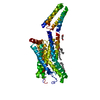 7zl9C 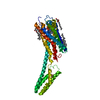 4pxzS S: Starting model for refinement C: citing same article ( |
|---|---|
| Similar structure data | Similarity search - Function & homology  F&H Search F&H Search |
- Links
Links
- Assembly
Assembly
| Deposited unit | 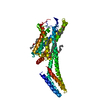
| ||||||||
|---|---|---|---|---|---|---|---|---|---|
| 1 |
| ||||||||
| Unit cell |
|
- Components
Components
| #1: Protein | Mass: 49817.527 Da / Num. of mol.: 1 Source method: isolated from a genetically manipulated source Source: (gene. exp.)   Homo sapiens (human), (gene. exp.) Homo sapiens (human), (gene. exp.)   Escherichia coli (E. coli) Escherichia coli (E. coli)Gene: HCAR2, GPR109A, HCA2, HM74A, NIACR1, cybC / Production host:   Spodoptera frugiperda (fall armyworm) / References: UniProt: Q8TDS4, UniProt: P0ABE7 Spodoptera frugiperda (fall armyworm) / References: UniProt: Q8TDS4, UniProt: P0ABE7 | ||||
|---|---|---|---|---|---|
| #2: Chemical | ChemComp-OLA /  Oleic acid Oleic acid#3: Chemical | ChemComp-OLC / ( | Has ligand of interest | Y | |
-Experimental details
-Experiment
| Experiment | Method:  X-RAY DIFFRACTION / Number of used crystals: 1 X-RAY DIFFRACTION / Number of used crystals: 1 |
|---|
- Sample preparation
Sample preparation
| Crystal | Density Matthews: 2.88 Å3/Da / Density % sol: 57.37 % |
|---|---|
Crystal grow | Temperature: 293 K / Method: lipidic cubic phase Details: 100mM pH5.4 sodium citrate, 60mM ammonium citrate, 36% PEG400, and 3% Additive 80 (40% PPG) |
-Data collection
| Diffraction | Mean temperature: 100 K / Serial crystal experiment: N |
|---|---|
| Diffraction source | Source:  SYNCHROTRON / Site: SYNCHROTRON / Site:  SPring-8 SPring-8  / Beamline: BL41XU / Wavelength: 1 Å / Beamline: BL41XU / Wavelength: 1 Å |
| Detector | Type: DECTRIS PILATUS3 6M / Detector: PIXEL / Date: Nov 27, 2015 |
| Radiation | Protocol: SINGLE WAVELENGTH / Monochromatic (M) / Laue (L): M / Scattering type: x-ray |
| Radiation wavelength | Wavelength : 1 Å / Relative weight: 1 : 1 Å / Relative weight: 1 |
| Reflection | Resolution: 2.7→47.972 Å / Num. obs: 25559 / % possible obs: 95.76 % / Redundancy: 5.6 % / CC1/2: 0.99 / Net I/σ(I): 10.18 |
| Reflection shell | Resolution: 2.7→2.752 Å / Num. unique obs: 1101 / CC1/2: 0.69 |
- Processing
Processing
| Software |
| ||||||||||||||||
|---|---|---|---|---|---|---|---|---|---|---|---|---|---|---|---|---|---|
| Refinement | Method to determine structure : :  MOLECULAR REPLACEMENT MOLECULAR REPLACEMENTStarting model: 4PXZ Resolution: 2.7→47.97 Å / Cross valid method: THROUGHOUT
| ||||||||||||||||
| Displacement parameters | Biso max: 193.39 Å2 / Biso min: 37.94 Å2 | ||||||||||||||||
| Refinement step | Cycle: LAST / Resolution: 2.7→47.97 Å
|
 Movie
Movie Controller
Controller



 PDBj
PDBj













